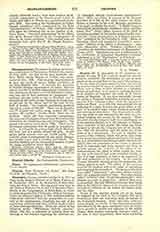

Chantry (M. E. chaunterie; O. Fr. chanterie; Fr. chanter, to sing; M. Lat. cantaria, cantuaria, whence cantarie, cantuarie), the endowment of one or more priests to say or sing Mass for the soul of the endower, or for the souls of persons named by him, and also, in the greater number of cases, to perform certain other offices, such as those of choir member in a collegiate church or cathedral, or of curate in outlying districts, or of chaplain in hospitals and jails, or of school-master or librarian. It was thus essentially, though not solely, a liturgical institution requiring as a sine qua non of its existence a place where the incumbent might say Mass. As a rule this was provided for by screening off a space between the great pillars of the nave or transept of some parish church or cathedral, and erecting an altar there. But frequently an addition was made to and opening into the choir, or a detached building was erected for the purpose. These detached chantry chapels, built in a churchyard, or in an outlying district, or at the entrance to bridges, often consisted of two stories, the lower one being devoted to the strictly religious uses of the foundation, while the incumbent used the upper one as his home or as a schoolroom. To erect a chantry the consent of the ordinary, which was given only when it was found that a fund sufficiently large for its building and maintenance had been set aside, had to be obtained; then the permission of the Crown to alienate lands in mortmain had to be secured; and then, to provide against the violation of the rights of the mother-church, the priest in whose parish the chantry was to be erected had to be consulted; finally, to give it a legal character, it had to be instituted by the civil authorities of the locality. In the erection of some chantries, beyond giving his permission, the bishop played no part. The donor, or his trustees, retained the funds as well as the right of appointing and removing the incumbent. Chantries of this kind were called “mercenary”, and were erected usually only for a definite period of time. Two other forms, called “collative” and “in private patronage”, were erected, as a rule in perpetuity. Both of these were ecclesiastical; the only difference between them being that in the latter the donor or his trustees named the incumbent, whereas in the former the bishop alone had the right. Traces of the chantry system are to be found in England as far back as the Conquest, but these foundations were not numerous until the middle of the fourteenth century. After that time, however, owing largely, no doubt, to the tremendous revolution effected by the great pestilences, and the subsequent growth in wealth and influence of the middle classes, their number constantly increased until, at the time of their suppression, there were, according to Heylin, 2374 of them. The work of suppressing and despoiling the chantries, begun by Henry VIII, was taken up and completed by his successor, Edward VI, in 1547. They yielded to the harpies that swarmed about his court 180,000 pounds. But the spirit which gave them birth could not be destroyed, and we see it manifesting itself in our own time in the erection of the Vaughan Chantry in the new cathedral of Westminster. Among the many evils attendant upon the suppression of the chantry the most grievous, perhaps, was the effect upon education. For the chantries were the grammar schools of the period—the incumbent “teaching gratis the poor who asked it humbly for the love of God“. Just how many of them had taken on this character of grammar school it is difficult to say. But that it was very large is seen from the fact that in 1562, nine years after Edward, the long-heralded “Father” of grammar schools, was dead, we find Williams, the Speaker of the House of Commons, in an address to the queen, referring to “the want of schools: that at least a hundred were wanting in England which before that time had been”—an allusion which we may safely assume had reference to the chantry schools. And Leach, who does not hesitate to call Edward “the Spoiler”, instead of “the Father” of schools, says that between 1547 and 1645 no grammar school was founded in England which had not already existed as a chantry. (See Schools.)
CORNELIUS HOLLAND

